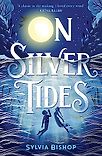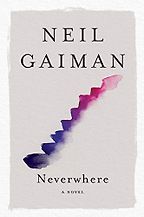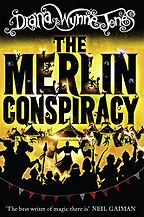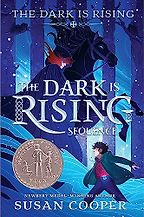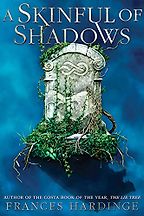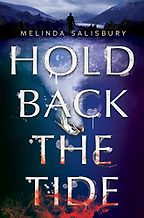I love fantasy books set in the real world – there’s a tantalising sense that they might be true, and the world they offer might be hidden just out of sight. When it comes to British settings, the history, geography and folklore are so full of rich oddities that it becomes especially hard to tell where an author’s invention ends, and their cultural inheritance begins. This blurred line is my favourite place to be!
There are some gorgeous fantasy books for teens that make use of Britain as a setting: some classics, some contemporary.
Neverwhere by Neil Gaiman
Suitable for middle-grade readers and up, but beloved of adult readers too, Gaiman’s debut novel Neverwhere makes playful use of geography: place names in London take corporeal form. Gaiman is taking inspiration from language here as much as place.
Richard Mayhew stops to help a young girl, Door, with dire consequences: he finds himself invisible to ‘London Above,’ and is forced to travel instead through ‘London Below’ – a hidden world of forgotten misfits, rats, and personified places. Teamed up with Door, his quest includes a visit to the Earl’s Court, a run in with the Black Friars, a little help with forging from Hammersmith, and a meeting with the Angel Islington – all references to London Underground stations. These London personae are mixed in with more obliquely inspired characters – the Marquis de Carabas is drawn from the tale of Puss in Boots, for example, while as far as I know Anaesthesia the Rat-Speaker is an entirely new creation. The result is one of my favourite effects in fantasy: the sense that a hidden world has left traces on our own world, in partial and jumbled fashion, just as a truly hidden world would. Of course one character shows up in a station name, and another in a legend, and another not at all.
London Below, then, really feels as though it could exist. And it has one other important virtue: the magical conceit replicates, and magnifies, how the real place feels. Yes, you can become invisible in London, and you can lose yourself underground – so why not literally? And who would be surprised, on arriving in the world of London’s lost, to find out that the rats are important citizens?
The Merlin Conspiracy by Diana Wynne Jones
Diana Wynne Jones also makes use of personified places in The Merlin Conspiracy, but here the geography encompasses all of Britain, which is visited on rotation by the King’s Court – the City of Salisbury is in play, as is down-at-heel Old Sarum, keen to remind anyone who will listen that he is only a poor rotten borough. But because this is Diana Wynne Jones, this idea is only a small fraction of the whole fantasy edifice.
First, a personal reason to love this book: Diana Wynne Jones replied to my fan mail when I was a young fantasy reader, and told me that I might enjoy her next book, The Merlin Conspiracy. Reader, I did. And I still have that letter framed on my bookshelf. But I promise that the book is still well worth reading, even if you don’t happen to have a treasured signed letter from the author telling you about it…
There are two protagonists, who tell the story in alternating chapters: Nick Mallory in our own Britain, and Roddy in parallel-universe-Britain, where the same recognisable geography is referred to as the Isles of Blest. The Merlin is a political office in Roddy’s Britain, alongside the King. The old Merlin has died, apparently of natural causes, but Roddy suspects foul play; and so she embarks on a perilous quest to uncover the political conspiracy at work, forced into an irritating alliance with Nick from the other-Britain. In a fashion typical of Diana Wynne Jones, we also spend time in liminal paths between the worlds. And we encounter co-existent, independent magic systems – Roddy’s father’s weather-working for the King’s Court has little to do with these liminal paths and the totems that live there, which have little in common again with the ultimate great powers evoked to save the day.
The strongest powers in this world are those drawn from British mythology, with an appearance from Gwyn ap Nudd – the ruler of the fair folk and leader of the wild hunt in Welsh folklore – proving decisive. Again, there is the sense that magical reality has left its imprint on our layman’s knowledge in various ways: we know something of Gwyn ap Nudd, and we once had a Merlin, although to Roddy’s great surprise this important political office has faded in our own Britain.
The Dark Is Rising by Susan Cooper
A variation on Merlin also appears in The Dark is Rising, and other Arthurian characters will appear throughout the series. The Dark is Rising is actually the second book of the series, but much like The Lion, The Witch and the Wardrobe, it dominates its predecessor – Over Sea, Under Stone – in popular imagination. It is also much better than Over Sea, Under Stone, and there’s a special fascination in reading one after the other – and imagining what happened in the interim, when Susan Cooper took herself from a competent writer of magical capers to a compelling narrator of myth-like, atmospheric, under-explained epics.
Will Stanton is the seventh son of the seventh son, and coming into his powers in a snow-buried village in Buckinghamshire round the mid-Winter solstice. He learns that he is the latest instantiation of one of the Old Ones, and locked in an ancient battle between Light and Dark. He needs to obtain certain signs, and keep them from the Dark Rider.
This central story is a textbook fantasy quest. But the book is brought to life by the contrast between this deeply unsettling magical world, which Will is assured he has inhabited before and must now re-inherit, and the world where we first found him: the hordes of siblings preparing for Christmas, wassailing and wrapping presents and worrying about the logistics of journeys through the snow. Both worlds are happening at once, and some characters can cross between the two. Whenever Will is cosy at home, we are wondering if he will shortly need to confront a magical foe he barely understands. Best read around Christmas time, somewhere snug.
A Skinful of Shadows by Francis Hardinge
In contemporary publishing, Hardinge is the queen of younger teen stories, a largely neglected space in young adult publishing right now. Her magical concepts are always elegant, with a single paranormal addition to our world that changes everything for the protagonist. Here, the premise is an unsettling one: some people have the capacity to store spirits of the deceased inside themselves – a living vessel for the dead.
Our hero Makepeace loses her mother in the first English Civil War, when a riot breaks out between Parliamentarians and Royalists. She is sent to her relatives, where she discovers her own status as a living vessel, and flees to Oxford. This brings the story right back into the heart of the war, which is no incidental backdrop – this is historical fantasy, heavily entwined with the real conflicts of the time.
Hardinge reliably offers rich reading for teens. Her books are thoughtful, and always packed full of an interesting ‘something else’ – here, the Civil War – in addition to the magical conceit. But the research never feels heavy handed, and Makepeace’s story is entirely compelling.
Hold Back The Tide by Melinda Salisbury
Another contemporary choice, Hold Back The Tide completely took me by surprise, and is an all-time favourite that deserves a much wider readership. It’s set in the Scottish Highlands, and follows Alva Douglas in her routine work checking the water-levels of the lochs. This odd task seems to be of great concern to her father. From the very opening, the tension is set to maximum: Alva’s father murdered her mother, and Alva has been biding her time until she can escape, fearing the consequences if he discovers her preparations and realises her intentions. From here, the dial is somehow turned up on the tension, as fantastical elements begin to creep into the narrative – and we no longer know who or what we should be most afraid of. The pace doesn’t let up until the shattering finale.
This is one of those books where story and setting seem perfectly in harmony, and you can’t imagine the events taking place anywhere else. Tales of loch monsters as we know them don’t feature, but the same deep cold mystery that inspired those tales makes Salisbury’s monsters feel perfectly plausible.
All these novels, in their various ways, are an homage to the feeling that lingers at the edges of Britain’s distinctive landscapes: ever-changing, often rain-and-wind-swept, and home to a tapestry of folklore that is deeply, joyfully bizarre.
My own book, On Silver Tides, uses the folklore of rivers and lakes in particular. Mythic water creatures appear in horrifying, mutually contradictory accounts, but also show up in more commonplace ways – Jenny Greenteeth, for example, is a river hag who snatches children, but also a name for duckweed. This made it easy to create that half-remembered, hidden-world effect that I love so much.
Here, the hidden world belongs to ‘silvermen’: a secretive amphibious community, living on houseboats and protecting the river. The story follows Kelda as she guards her little sister, Isla. Isla can’t breathe under water, and should have been sent away from the family’s boat at birth. When the waterways sicken, Isla is blamed, and they flee.
From here, the journey was heavily constrained by the geography of Britain’s rivers – I quickly learned that travelling underwater drastically changes your view of the country! As well as following the rivers’ routes, I started viewing the country in terms of geology and its effects on water – where are the rivers sharp and acidic; where are they soft, running over chalk-beds; which would still be fed by groundwater in summer, and which would flood suddenly in winter? And topography too: in Scotland, the tumbling rivers aren’t navigable by houseboat until you reach the Caledonian Canal. That makes Scotland a semi-magical place to this boat-dwelling culture.
It was a joy to write something so rooted in place. And it was British fantasy books and legends that taught me to love hidden, half-forgotten worlds: snowy lands at the backs of wardrobes, cities under cities, slumbering Old Ones, sleeping heroes, dragons-in-hills, ladies-in-lakes, and dangerous fairies in the hollows underground.
February 9, 2024. Updated: February 29, 2024
Five Books aims to keep its book recommendations and interviews up to date. If you are the interviewee and would like to update your choice of books (or even just what you say about them) please email us at [email protected]
Five Books interviews are expensive to produce. If you've enjoyed this interview, please support us by donating a small amount.

